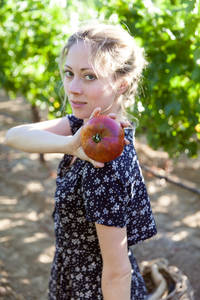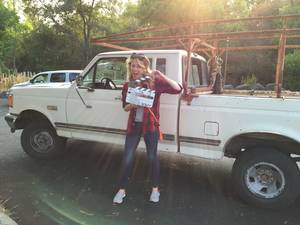When her acting career grew unsatisfying, Paten Hughes found escape in the tomato garden. But her hiatus from the industry produced more than delicious produce. Hughes’s experience inspired her to create the new hit web series, Heirloom (streaming now on Vimeo). Hughes worked with writer Bekah Brunstetter (This Is Us, Switched-at-Birth) to develop a story arc following the character of Emily, a New York City-based actress who ventures across the country to Northern California after she inherits a small patch of farmland from her uncle. Emily is played by Hughes herself, supported by an outstanding cast of co-stars including Ryan Cooper, Luis Vega, Margaret Colin (Gossip Girl), and Tom Wopat (Dukes of Hazard).
Lydia Plantamura: Heirloom is based on actual experiences. Can you share more of the true events that inspired the web series?
Paten Hughes: Heirloom basically started after some friends suggested I turn my adventures in tomato farming into a story for the screen. I had stumbled into tomato farming after a film project fell apart (story of many actors’ lives). At that point in my career, I had been watching my friends get married and have children and get promotions and buy houses. And I was waking up to a hustle, to a grind that is addicting but also exhausting and somewhat intangible. There are moments when being an actor feels a bit like building a sandcastle. You don’t know when a wave is going to come and wash it away; you don’t know when a bigger kid will accidentally step on it. But for brief moments here and there, you look at this mansion you’ve proudly and delicately carved. And then you start over again when a play ends, when the TV show is over, when a part gets given to someone else.
I was simultaneously frustrated with the roles I was being offered or some of the shitty things you go through auditioning. Feeling like I needed to reconnect to my creativity and what I was passionate about, I sort of found that by planting tomatoes. (To each their own!) I didn’t know anything about cooking or gardening or food or how to make invoices. The “real” Raul was a rock and constantly laughing at my farming ignorance. Without giving away too much of the story, I also ended up dealing with what you start to see in episode nine: one of the prices you pay for creating a successful business!
LP: You’re pretty much playing the role of yourself in the series. What is it like acting in your own story?
PH: I think that ultimately, you need to always approach a role as if you are creating a completely new character and person to anyone you’ve played before—or even yourself! I’m sure there are ways that the character of Hannah in Girls is different from Lena Dunham, or Frances in Frances Ha is different from Greta Gerwig. What is actually on the page—the script—has to be your manual. Some of the details in Emily’s life were different from mine, some of her backstory or her experiences. I think what was helpful for me was to think about all of the ways we were similar versus all of the ways we were different, and to try to be clear on both of those before just letting go and letting it breathe. It also helped having a director who could catch me if I strayed from the character we were trying to create in Emily.
LP: Heirloom begins in the hustle and bustle of New York City, but the main character, Emily, soon moves to the rural valleys of Sonoma County, California. What was it like filming across two locations?
PH: It was a joy: like being able to reunite with long lost friends. I think our director, cinematographer, and production designer were the main creatives that worked on both coasts; they held everything together and made sure there was consistency in vision and voice across the board. Being able to film in Sonoma was such a gift because we all got to discover this quiet, beautiful and delicious plot of earth together. We attended the annual Alexander Valley Association picnic, had dinners in town and were treated like royalty by so many of the locals, and had production meetings on the deck overlooking the gorgeous Kinsella Estates Vineyard. It couldn’t have been more beautiful! (Although, it was often 100 degrees while filming—I suppose that could have been better.) The New York shoot was much tighter: we had a smaller crew, we were crammed into spaces, etc. You can see that in the footage, as well.
LP: I recently spent some time myself in Northern California (very close to Sonoma, actually) living on farmland. You can be pretty isolated in those valleys and hills. On the show, Payton struggles with GPS, wifi, and cell service—some very real first world struggles. Did the cast or crew experience any of these difficulties while filming on location?
PH: We had some problems connecting to the wifi, we had a flat tire, we got one of our trucks stuck on a hill, we had some goat issues, I think. When you see Emily cruising down the road in episode two, that’s me driving in third gear for the first time with our assistant director John Stern screaming for his life on the floor of the backseat. (I spent my off mornings learning how to drive stick shift and being cleared as “safe to drive on an actual road” by several folks.) The distance between everything was likely one of the hardest things to work with as it cut into days: the tomato garden was a half hour away from the house, Lynn Brown’s is fifty minutes away, the hotels are always spaced everywhere, etc.
One of the biggest reasons you plan and work quickly on a film set is because you don’t know what is going to happen the next moment: an actor might get sick, a truck with all your lighting equipment might break down and delay your filming three hours, your dog might not want to get off the Kubota and come to set, you lose a location. If you plan well and you work as a team, all of those difficulties become gems. When I look back on the experience of filming, this smile crosses my face as I picture all of the things that went “wrong.” They’re your favorite part.
LP: Whenever food is an essential part of the story, a film should include some good sequences of “food porn.” Heirloom is filled with tantalizing shots of big, juicy tomatoes. They look so delicious! I have to know: Where did the on-screen tomatoes come from?
PH: From the backyard! I’m almost positive that I grew all of the tomatoes we used. (Though, I’d have to check with our props master to be sure we didn’t end up biting into all of the ones we trekked over to Calistoga the day we were filming on Lynn Brown’s farm and had to borrow a couple from him.)
LP: I loved the music: alternative rock with female vocals. What musical artists are featured on the soundtrack?
PH: Right?! Our music features many original songs by Laura Brenneman, in addition to Bikini Carwash, Jacob 2-2, and Siemba.
LP: What are some of the benefits and limitations of the short episode, web series medium?
PH: I think one of the hardest parts about making a web series is that even now, if you’re having a conversation with people outside of the industry or outside the millennial generation, people still don’t know what a web series is. There’s this connotation that it’s your friend’s son’s pet project that he filmed on his iPhone and threw up on YouTube. One of our goals with Heirloom was to try to change that perspective: to celebrate the need for short form content, but also nod back towards more traditional story arcs and artistry within it. Most of our actors are not YouTube stars but decorated and respected theatre actors. Our director has worked in theatre, as well as television and independent film. And our writer is on the highly acclaimed NBC show This Is Us.
Benefits-wise, I think we were able to tell what we wanted to tell and not worry about spreading the story out in order to fill a half-hour time slot or traditional episodic arc. You get more of a sense of what we thought were the important parts to the story and the necessary action.
LP: Do you feel like you have more creative freedom working in this format? Less?
PH: More by far! There’s this sense of being able to honor the story and do what is right by it without forcing it into being a feature film or an hour drama or half hour comedy: you get to create your own form (while always minding the rules for traditional storytelling).
LP: The show has already reached over 2.5 million views. How have you been promoting Heirloom?
PH: We’re over 3.5 million now actually! Vimeo has been a great partner for us, and we’ve had a lot of help from great press and some celebrity chefs tweeting about us. We’ve done a few Facebook ads, but it’s really just word of mouth and people stumbling upon us one way or another. The great thing about the Vimeo platform is that if someone is watching a related video, it will link to us. We get little notes almost daily from people who have discovered us that way. We also passed out 1,000 biodegradable bags of heirloom tomatoes in Union Square [San Francisco] on the day we premiered as a way to celebrate—not sure how much help that did, but we had fun doing it!
LP: What does the timeline look like for season two? When can viewers expect to pick back up with Emily, Roger, and Bobby?
PH: Gosh, I get asked this a lot, and I wish I had an exact answer! We’re hoping more and more people keep being vocal on social media about wanting a season two and spreading the word to their friends. In the meantime, we’re exploring and creating! We are grateful for all of the support and love our fans have shown us, and we want to keep the tomato’spiration going.
Watch all 9 episodes of Heirloom season one, streaming now on Vimeo at: https://vimeo.com/heirloomtheseries
Author Biography
Lydia Plantamura has served on the editorial board for Film Matters magazine and is currently working as an intern. A recent graduate, she studied creative writing and film studies at the University of North Carolina Wilmington. Lydia is an avid traveler. When she isn’t writing, she enjoys exploring the U.S., falling in love with the natural beauty of states like North Carolina, Hawaii, and California.












































